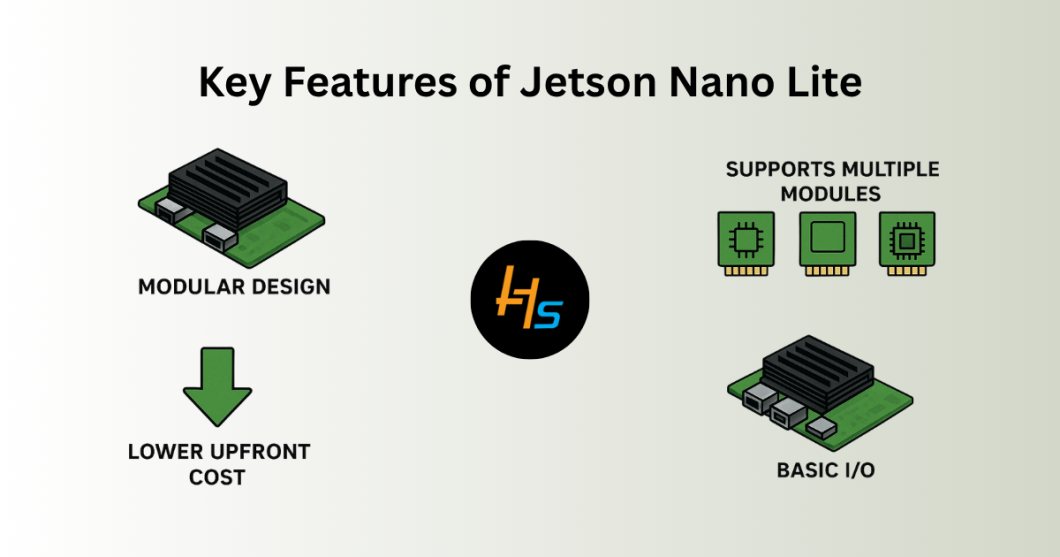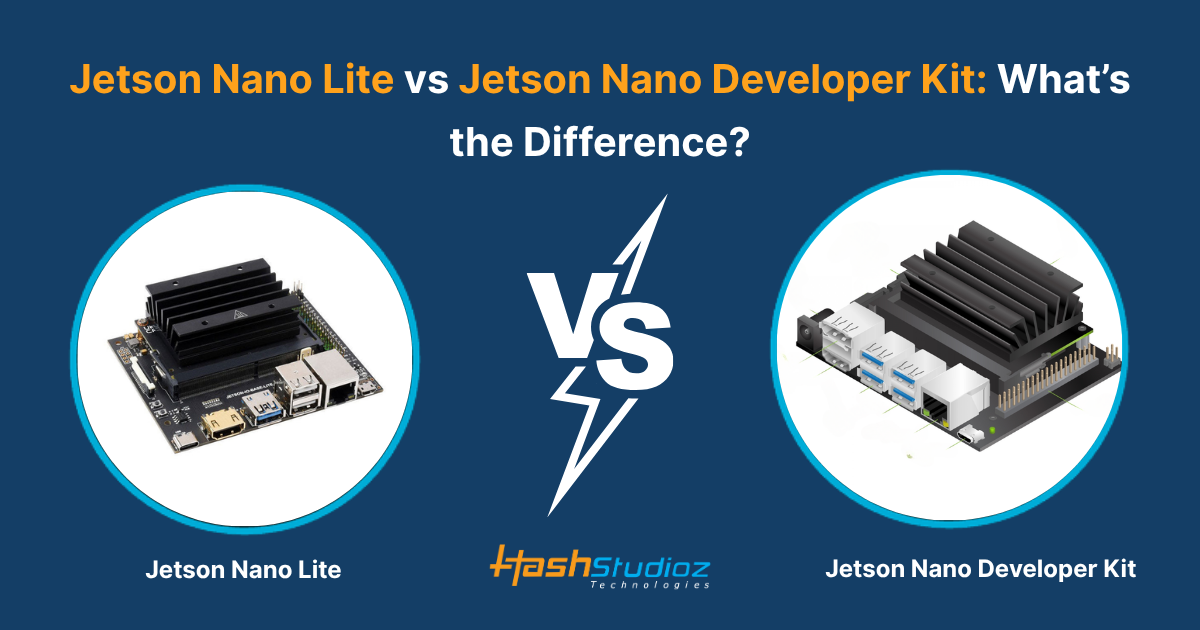The NVIDIA Jetson Nano series has become a cornerstone for developers working on AI and machine learning projects at the edge. Its compact size, GPU-accelerated performance, and support for AI frameworks have made it popular for robotics, computer vision, smart devices, and educational projects.
Recently, NVIDIA introduced the Jetson Nano Lite alongside the existing Jetson Nano Developer Kit. While they share the same core computing power, these two products serve different purposes and audiences. Understanding their differences helps users pick the right hardware for their projects, balancing cost, flexibility, and development convenience.
Table of Contents
- Overview of the Jetson Nano Platform
- What Is the Jetson Nano Lite?
- What Is the Jetson Nano Developer Kit?
- Why Jetson Nano Lite is the Best Entry Point for Edge AI Development
- Detailed Comparison of Jetson Nano Lite and Jetson Nano Developer Kit
- Performance and Use Cases
- Pricing and Availability
- Real-World Example
- Partner with HashStudioz for Your Jetson Nano Projects
- Conclusion
Overview of the Jetson Nano Platform
NVIDIA’s Jetson Nano platform is designed to provide high-performance AI computing in a small, power-efficient package. The platform supports deep learning frameworks such as TensorFlow, PyTorch, and Caffe, enabling real-time image recognition, object detection, and other AI workloads.
Key components in the Jetson Nano hardware include:
- CPU: Quad-core ARM Cortex-A57 processor running up to 1.43 GHz.
- GPU: NVIDIA Maxwell architecture GPU with 128 CUDA cores.
- RAM: Typically 4GB LPDDR4.
- Storage: Supports microSD cards for OS and data storage.
- Connectivity: Ethernet, USB, HDMI, and camera interface support.
The Jetson Nano Developer Kit has been a popular choice for developers since its release, offering a full development environment with all hardware components included.
What Is the Jetson Nano Lite?
The Jetson Nano Lite is a newer option designed to provide greater flexibility and lower entry cost for embedded AI projects. Unlike the Developer Kit, the Lite version does not include the Jetson module (the core computing part that contains CPU, GPU, RAM, and flash storage).
Instead, the Lite consists of a carrier board that provides power, I/O connectors, and expansion ports but requires a separate purchase of the Jetson module. The modules compatible with the Lite version come with either 2GB or 4GB of RAM, giving users the choice based on their performance or budget needs.
Key Features of Jetson Nano Lite:

- Modular Design: The separation of module and carrier board allows users to customize hardware configurations.
- Supports Multiple Modules: Users can choose between 2GB or 4GB RAM modules.
- Lower Upfront Cost: Since the module is bought separately, initial investment can be reduced if modules are sourced or reused.
- Basic I/O: Carrier board includes standard USB, HDMI, power input, and camera connectors but fewer ports compared to Developer Kit
What Is the Jetson Nano Developer Kit?
The Jetson Nano Developer Kit is a complete development board that includes the Jetson Nano module pre-installed on a reference carrier board designed by NVIDIA. It is meant as a ready-to-use platform, making it easy for developers to start building and testing AI applications without assembling parts.
Key Features of Jetson Nano Developer Kit:
- All-in-One Package: Comes with Jetson Nano 4GB module integrated.
- Comprehensive I/O: Multiple USB 3.0 ports, HDMI 2.0 output, Gigabit Ethernet, camera interfaces, and more.
- Standard Form Factor: Dimensions roughly 100mm x 80mm.
- Power Options: Supports 5V micro-USB power or DC power adapter.
- Pre-Installed Software: Includes NVIDIA’s JetPack SDK for AI development.
- Community Support: Large user base, extensive documentation, and example projects.
Why Jetson Nano Lite is the Best Entry Point for Edge AI Development
Edge AI is rapidly growing, enabling devices to process data and make decisions locally without relying on cloud connectivity. This reduces latency, improves privacy, and cuts down bandwidth use. For developers and organizations eager to enter the world of edge AI, selecting the right hardware is critical.
The Jetson Nano Lite from NVIDIA stands out as one of the best entry points into edge AI development. Here’s why:
1. Modular Design Provides Flexibility
Unlike traditional all-in-one boards, the Jetson Nano Lite separates the core computing module from the carrier board. This modular design lets you:
- Customize your hardware: Choose a Jetson module with the RAM size that fits your application, whether 2GB or 4GB.
- Build tailored solutions: Integrate the Lite into your own custom device or hardware platform.
- Upgrade easily: Replace or upgrade the Jetson module without redesigning the entire system.
This flexibility is rare at this price point and perfect for developers learning to design edge AI systems.
2. Lower Cost of Entry
The Jetson Nano Lite carrier board is affordable, costing significantly less than full developer kits. You pay only for the carrier board initially, then select the module that fits your budget and performance needs.
This makes the Lite ideal for:
- Students and hobbyists with limited budgets.
- Small startups prototyping multiple hardware configurations.
- Projects where only the computing module or carrier board needs replacement.
3. Same Powerful Core as Jetson Nano Developer Kit
Despite the modular design and lower price, the Jetson Nano Lite uses the same ARM Cortex-A57 CPU and 128-core NVIDIA Maxwell GPU architecture found in the full developer kit. This means:
- Strong AI processing power capable of running popular AI frameworks like TensorFlow and PyTorch.
- Compatibility with NVIDIA JetPack SDK, which provides optimized AI libraries and tools.
- Performance on par with more expensive boards, given the same module.
4. Compact and Scalable for Custom Projects
The smaller carrier board of the Jetson Nano Lite is designed to fit into compact or embedded environments. Developers can:
- Integrate the carrier board easily into custom enclosures or devices.
- Use the GPIO pins and interfaces to connect sensors, cameras, or actuators.
- Scale projects from prototypes to production hardware without redesigning the system.
5. Strong Software Ecosystem Support
The Jetson Nano Lite fully supports NVIDIA’s JetPack SDK. This software suite includes:
- CUDA Toolkit for GPU acceleration.
- TensorRT for optimized neural network inference.
- cuDNN for deep learning primitives.
- Multimedia APIs for camera and video processing.
With the Lite, you get the same powerful development environment as the Developer Kit, backed by extensive documentation and community support.
Detailed Comparison of Jetson Nano Lite and Jetson Nano Developer Kit
Here’s a side-by-side comparison to clarify differences:
| Feature | Jetson Nano Lite | Jetson Nano Developer Kit |
| Module Included | No (sold separately) | Yes (4GB module included) |
| RAM Options | 2GB or 4GB LPDDR4 | 4GB LPDDR4 |
| CPU | ARM Cortex-A57 | ARM Cortex-A57 |
| GPU | 128-core Maxwell | 128-core Maxwell |
| Storage | microSD card (user supplied) | microSD card (user supplied) |
| USB Ports | Limited (usually one USB-C) | Four USB 3.0 ports |
| HDMI | Yes | Yes |
| Ethernet | Limited or none (depends on carrier board) | Gigabit Ethernet |
| Camera Support | CSI interfaces | CSI interfaces |
| GPIO Pins | Basic | Extended |
| Price (approximate) | $49 – $59 | $99 |
| Target User | Embedded developers, custom projects | Beginners, prototyping, education |
Performance and Use Cases
Since both the Jetson Nano Lite and Developer Kit use the same CPU and GPU architecture, their raw computing power is similar, assuming the same module is used with the Lite version. The main performance difference comes from the RAM options and available peripherals.
1. Jetson Nano Lite Use Cases:
- Custom Hardware Projects: Ideal for embedding AI into custom PCBs or systems with specific size or interface needs.
- Low-Cost AI Devices: Perfect for users aiming to minimize hardware expenses.
- Educational Projects: Good for learning modular system design and AI development.
- Edge Devices: Suitable for industrial IoT or robotics projects where minimal I/O is needed.
2. Jetson Nano Developer Kit Use Cases:
- Rapid Prototyping: Fast setup with all necessary ports and ready-to-use software.
- AI Development and Testing: Useful for developers experimenting with various sensors and peripherals.
- Learning Platform: Suitable for students and beginners because it offers a plug-and-play experience.
- Robotics and Computer Vision: Wide I/O support makes it easy to connect cameras, sensors, and actuators.
Pricing and Availability
Pricing plays a significant role in deciding between these two.
- Jetson Nano Lite: Starts at about $49 for the carrier board. The modules (2GB or 4GB) cost between $59 to $99 depending on specs and availability. Overall, you can control your budget by selecting the module you need.
- Jetson Nano Developer Kit: Costs about $99 and includes the module and board. This price is higher but justified by the convenience and additional I/O options.
Real-World Example
Imagine you want to build a home security camera with AI detection:
- If you use the Developer Kit, you can connect USB cameras, Ethernet for networking, and HDMI to view results on a monitor immediately. It’s easy to set up and prototype.
- If you want a smaller device embedded inside a custom enclosure with limited I/O, the Lite version gives you the flexibility to integrate only required interfaces, potentially reducing size and cost.
Partner with HashStudioz for Your Jetson Nano Projects
At HashStudioz, we specialize in AI and edge computing solutions using platforms like the Jetson Nano Lite and Developer Kit. Our experienced team can help you:
- Build custom AI-powered applications for robotics, IoT, and computer vision.
- Design and integrate hardware-software solutions tailored to your project’s needs.
- Optimize performance with NVIDIA JetPack SDK for faster, more efficient edge AI deployments.
Whether you’re a startup exploring prototypes or an enterprise scaling production, HashStudioz delivers the expertise and support you need to bring your ideas to life.

Conclusion
The Jetson Nano Lite offers a modular, flexible hardware option with fewer I/O ports and variable performance based on the module chosen. In contrast, the Jetson Nano Developer Kit provides an integrated board with extensive I/O and fixed 4GB RAM. Both support the same JetPack SDK, but the Lite is lower cost, ideal for embedded developers, while the Developer Kit suits beginners and rapid prototyping.

